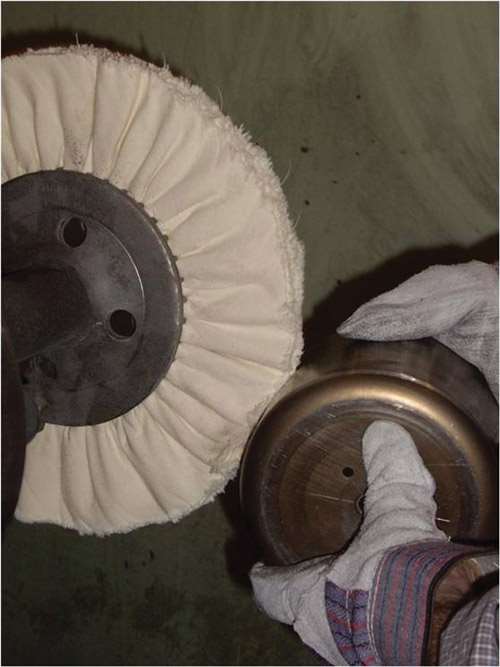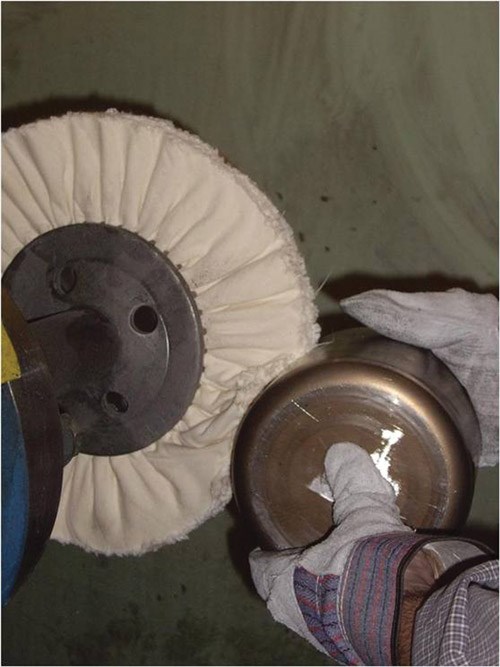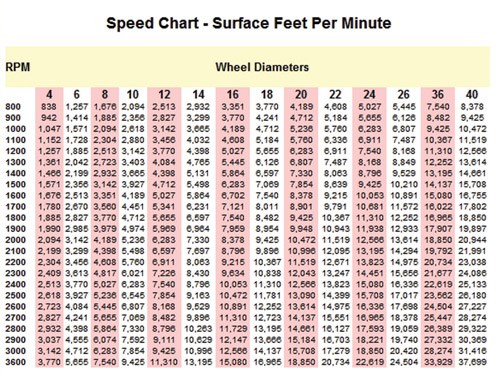Published
Buffing & Polishing: The Need for Speed
The correct peripheral speed is an important consideration in getting the right results from your buffing operation. A buff that is turning too fast or too slow may result in damage to the buff or to the workpiece.
Paul Schaffner, Vice President of Sales , Schaffner Mfg. Co. Inc
The correct peripheral speed is an important consideration in getting the right results from your buffing operation. A buff that is turning too fast or too slow may result in damage to the buff or to the workpiece.
Buff wheel speed and buffing wheel pressure are two elements that must work together to produce the best finish in a safe, economical way. Proper pressure must be applied to the workpiece to produce the friction that allows the compound to buff. In tangential buffing, enough pressure should be applied to the workpiece to cause the buffing wheel to flare slightly at the point of contact.
Inadequate pressure gives no buffing action, but excess pressure may cause the speed of the buffing wheel to be reduced and/or cause the buff to collapse and the operation to be less efficient or even dangerous.
One of three chief causes of buffing wheel fires is excessive pressure. The cause of a fire can be determined by where the fire starts on the buffing wheel. If it starts at the ring it usually means that the buff is spinning on the shaft and the head was not tightened properly. If the fire starts in the middle of the buff, it usually means that too much pressure is being applied. If the fire starts at the periphery of the buff it usually means that the buff is turning too fast or not enough compound is being applied.
To assist you in determining the proper buff wheel speed for your operation, we have created a speed chart. The speed chart is meant to act as a guideline or starting point and may be adjusted slightly for your operation.
Determining Peripheral Speed of a Buffing Wheel
For reasons of economy and efficiency, ‘surface feet per minute’ (SFPM) for each buffing or polishing operation is an important factor. The measure of this SFPM is determined by the peripheral speed of the buffs or wheels, which in turn furnishes the number of linear feet polished by the face of the wheel within a definite period of time. By knowing the peripheral speed of a wheel, the finisher can establish a formula to determine either the diameter of the wheel or the revolutions per minute of the shaft for a given polishing or buffing job.
To determine the peripheral speed of a wheel or the number of linear feet traveled per minute on its outer perimeter (face), multiply the revolutions per minute of the lathe spindle by the circumference of the wheel (in feet). The circumference is the result of diameter times 3.1416 (pi). For example, the known R.P.M. of a spindle or the arbor is 800. The wheel diameter is 4 inches or 1/3 ft.
Multiply 1/3 × 3.1416 = 1.0472.
Multiply 1.0472 × 800 = 837.16 surface feet per minute. Average peripheral speeds are approximately 7,500 linear feet per minute for buffing.
In order to determine the size of wheel necessary to obtain 7,500 linear feet, divide the peripheral speed or 7,500 by the R.P.M. at spindle or arbor. Then divide that result by 3.1416 which will determine the diameter of the wheel in feet or fractions of feet.
For example, 7,500 divided by 2300 = 3.260.
Divide 3.260 by 3.1416 = 1.0377 feet or 12.45 inches.
Therefore, if you were cut buffing aluminum extrusions and your lathe was turning at 2,300 RPMs your buffing job would call for a 12- or 14-inch-diameter wheel based on the above recommended speed chart for tangential buffing. In this case the 14-inch-diameter wheel would be a good choice as it allows to the finisher to stay within the recommended range for a longer period as the wheel wears.
Buffing and polishing can be dangerous occupations, and extreme care should be used when operating any buffing wheel. If a wheel should disengage during use, it could cause serious injury to any unprotected body parts.
Now that you have determined the proper diameter of the buffing wheel for your finishing job, the following buffing wheel safety information should be considered before the finishing job is started:
Safety is also key
The following are guidelines for the safe operation of buffing wheels, but they are by no means a substitute for common sense. If you have any questions concerning the overall safety of a particular buffing application, always consult your foreman or your safety department.
1) Be sure that the end flanges of the wheel meet OSHA standards, and that they are of sufficient diameter to extend the outer tip of the teeth in the clinch ring. Do not use buffing wheel flanges that are either smaller or larger than the outer tips of the teeth in the clinch ring.
2) The diameter of the buffing wheel shaft should match the diameter of the arbor hole.
3) Prior to installation of a buffing wheel buff, examine the product for defects or damage.
4) Carefully mount the buffing wheel, making sure that its tails trail the direction of rotation.
5) If spaces are used between buff sections, the outside must be large enough to cover the tip of the teeth in the clinch ring. If a spacer supports the buff center, be sure that the support area is the correct diameter, and gives support to the entire inside diameter of the clinch ring. Make sure that the wheel flange areas of the spacer securely clamp the clinch ring of the buff. NOTE: If buffs spin on the hub or spacer, fires or clinch ring breakage may occur.
6) Excessive or unusual vibration would indicate the need for corrective action. Shut the machine down immediately, determine the cause, and correct the situation.
7) Never bypass machine manufacturers’ recommendations concerning the safe operation procedures.
8) Use and maintain the dust collection system.
9) For small and irregular shaped parts, the use of properly designed holding devices is suggested.
10) Never leave a machine running unattended.
11) Never permit clothing, hair, jewelry, or other loose articles to get between the rotating buff wheel and or the workpiece fixture.
12) Always use protective glasses and or face shields as recommended in ANSI Standard Z87.1.
13) Observe all safety recommendations of your own Safety Engineering Department, the machine manufacturer, and your compound suppliers.
14) Always use the appropriate body protection devices such as - leather gloves, safety shoes, aprons, safety glasses, hair net or hat, and breathing masks, as warranted by the operation.
15) Be sure that the thread on arbor shaft is in good condition so the nut can be screwed on freely, and that the threaded portion of the shaft is sufficient to allow firm clamping of buff flanges.
16) Tighten shaft nut securely with adequate wrench.
17) Be sure that the nut remains tight. Retighten occasionally if necessary.n
Paul Schaffner is vice president of sales at Schaffner Mfg. Co., Inc. He can be reached at 412-761-9902, or at paul@schaffnermfg.com. For information on fireproof buffing wheels, contact Schaffner Manufacturing at sales@schaffnermfg.com
RELATED CONTENT
-
Polishing vs. Buffing: What's the Difference?
Is polishing the same as buffing? Mechanical finishing expert, Pat Wenino, explains the differences between the two processes.
-
Chemically Accelerated Vibratory Surface Finishing (CAVSF) with Oxalic Acid-Based Solutions
It has been shown that the inexpensive chemically accelerated vibratory surface finishing (CAVSF) process can reduce the average surface roughness.
-
Glass Bead Blasting as Plating Pretreatment
What are the best practices for using blasting in preparation for plating? Angelo Magrone of Bales Metal Surface Solutions discusses the ins and outs of glass bead blasting.



















